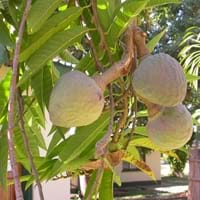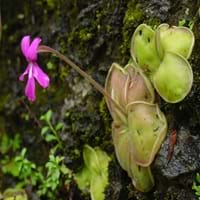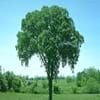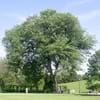Life Span
Perennial
Perennial
Origin
Asia, Caribbean, Central America
World/Pandemic
Types
Not Available
Pinguicula vulgaris, Pinguicula moranensis, Pinguicula alpina
Habitat
secondary forest, Tropical Forests
Damp Places, Fens, Gravels, meadows, Moist Soils, shores, Shores of rivers or lakes, springs, Wet lands
USDA Hardiness Zone
3-8
Not Available
AHS Heat Zone
8-1
Not Available
Sunset Zone
1a, 1b, 2a, 2b, 3a, 3b, 4, 5, 6, 7, 8, 9, 10, 11, 12, 13, 14, 15, 16, 17
Not Available
Habit
Pyramidal
Rosette/Stemless
Flower Color
Light Yellow
Not Available
Flower Color Modifier
Bicolor
Not Available
Fruit Color
Gray Green, Sandy Brown
Not Available
Leaf Color in Spring
Green
Not Available
Leaf Color in Summer
Dark Green
Not Available
Leaf Color in Fall
Yellow, Light Yellow, Yellow green, Sandy Brown, Ivory
Not Available
Leaf Color in Winter
Not Available
Light Green
Leaf Shape
Lanceolate
Circular
Plant Season
Spring, Summer, Fall
Spring, Summer, Fall, Winter
Sunlight
Full Sun, Partial Sun
Full Sun, Partial Sun, Partial shade
Growth Rate
Medium
Medium
Type of Soil
Clay, Loam
Loam, Sand
The pH of Soil
Acidic, Neutral, Alkaline
Acidic
Soil Drainage
Well drained
Average
Bloom Time
Early Summer
Late Spring, Early Summer, Summer
Tolerances
Pollution, Drought
Drought
Where to Plant?
Ground
Container, Ground, Pot
How to Plant?
Grafting, Seedlings
Root Division, Seedlings
Plant Maintenance
Medium
Medium
Watering Requirements
Average Water Needs
Average Water Needs, Get enough water whenever the soil is dry, Keep ground moist
In Summer
Lots of watering
Lots of watering
In Spring
Moderate
Moderate
In Winter
Average Water
Average Water
Soil pH
Acidic, Neutral, Alkaline
Acidic
Soil Type
Clay, Loam
Loam, Sand
Soil Drainage Capacity
Well drained
Average
Sun Exposure
Full Sun, Partial Sun
Full Sun, Partial Sun, Partial shade
Pruning
Prune in the growing season, pruning needed for strong structure, Remove dead branches
Remove damaged leaves, Remove dead branches, Remove dead leaves
Fertilizers
All-Purpose Liquid Fertilizer, Compost, High phosphorus
All-Purpose Liquid Fertilizer
Pests and Diseases
Aphids, Downy mildew, Leaf rust, Mites, Squirrels
Red blotch
Plant Tolerance
Salt and Soil Compaction, Sun
Drought
Flowers
Insignificant
Yes
Flower Petal Number
Single
Single
Foliage Texture
Coarse
Medium
Foliage Sheen
Glossy
Matte
Attracts
Butterflies, Hummingbirds, Not Available, Squirrels
Insects, Not Available
Allergy
Nausea, Vomiting
Pollen
Aesthetic Uses
Not Available
Showy Purposes
Beauty Benefits
Anti-ageing, Maintains teeth healthy, Remove blemishes
Not Available
Environmental Uses
Air purification, Food for animals, Food for birds, Shelter for wildlife
Air purification
Medicinal Uses
Antibiotic, anti-cancer, Anti-oxidant, Cardiovascular problems, Diarrhea, Fever, Improve heart health
Antispasmodic, Antitussive, Cough, Throat infection
Part of Plant Used
Fruits
Leaves
Other Uses
Culinary use, Grown for shade, Oil is used in perfume, soaps, creams, etc., Used for its medicinal properties
Not Available
Used As Indoor Plant
No
Yes
Used As Outdoor Plant
Yes
Yes
Garden Design
Feature Plant, Fruit / Fruit Tree, Shade Trees
Alpine, Bog Garden, Container, Houseplant, Rock Garden / Wall, Wildflower
Botanical Name
Annona reticulate
PINGUICULA
Common Name
wild-sweetsop, bullock's-heart, ox-heart
Butterwort
In Hindi
ramphal
Butterwort plant
In German
Netzannone
Fettkraut Pflanze
In French
cachiman, cœur de bœuf
plante Butterwort
In Spanish
Annona reticulata
planta butterwort
In Greek
Ramphal
φυτό Butterwort
In Portuguese
coração-de-boi
planta Butterwort
In Polish
Flaszowiec siatkowaty
Butterwort roślin
In Latin
Ramphal
Butterwort herba
Phylum
Magnoliophyta
Magnoliophyta
Class
Magnoliopsida
Magnoliopsida
Order
Magnoliales
Scrophulariales
Family
Tiliaceae
Lentibulariaceae
Clade
Angiosperms, Magnoliids
Angiosperms, Asterids, Eudicots
Tribe
Annoneae
Not Available
Subfamily
Annonoideae
Asteroideae
Season and Care of Ramphal and Butterwort
Season and care of Ramphal and Butterwort is important to know. While considering everything about Ramphal and Butterwort Care, growing season is an essential factor. Ramphal season is Spring, Summer and Fall and Butterwort season is Spring, Summer and Fall. The type of soil for Ramphal is Clay, Loam and for Butterwort is Loam, Sand while the PH of soil for Ramphal is Acidic, Neutral, Alkaline and for Butterwort is Acidic.
Ramphal and Butterwort Physical Information
Ramphal and Butterwort physical information is very important for comparison. Ramphal height is 1,220.00 cm and width 760.00 cm whereas Butterwort height is 152.40 cm and width 60.96 cm. The color specification of Ramphal and Butterwort are as follows:
Ramphal flower color: Light Yellow
Ramphal leaf color: Green
Butterwort flower color: Not Available
- Butterwort leaf color: Not Available
Care of Ramphal and Butterwort
Care of Ramphal and Butterwort include pruning, fertilizers, watering etc. Ramphal pruning is done Prune in the growing season, pruning needed for strong structure and Remove dead branches and Butterwort pruning is done Remove damaged leaves, Remove dead branches and Remove dead leaves. In summer Ramphal needs Lots of watering and in winter, it needs Average Water. Whereas, in summer Butterwort needs Lots of watering and in winter, it needs Average Water.





